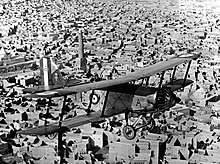Westland Wapiti
| Westland Wapiti | |
|---|---|

|
|
| Type: | Multipurpose aircraft |
| Design country: | |
| Manufacturer: | |
| First flight: |
March 7, 1927 |
| Commissioning: |
June 1928 |
| Production time: |
1927 to August 1932 |
| Number of pieces: |
585 |

The Westland Wapiti was a British two-seat multipurpose aircraft of the 1920s. It was a biplane built by Westland Aircraft according to Air Ministry tender 26/27 , which was to replace the Airco DH9 A in the Royal Air Force .
history
In order to save time, the Air Ministry's tender required the use of a large number of components from Airco DH9 A. Westland had the advantage of already being a major contract manufacturer of DH9A and was awarded the contract to build 25 aircraft. The first prototype took off on its maiden flight on March 7, 1927.
The Wapiti was a conventional biplane with two open pilot seats one behind the other. The model came into operational use for the first time with the No.84 Squadron of the RAF in June 1928 in Iraq . It was also used in India and was also used by the Australians and Canadians . The latter were also used by the elk at the beginning of the Second World War .
The prototype of the Wapiti V with the registration G-AAWA was demonstrated in Argentina and Uruguay with swimmers. Then he got under the name Westland PV-6 (also known as Houston-Wallace known) a Bristol Pegasus - radial engine and the registration G-ACBR. This aircraft, piloted by Flt. Lt. DF McIntyre and a Westland PV-3 accompanying him were the first aircraft to fly over Mount Everest on April 3, 1933 . The PV-6 was later renamed the Wallace Mk.I and received some improvements. A total of 68 Wapitis were converted to the Wallace Mk.I.
Military operator
variants
All variants were Westland in Yeovil built
- Wapiti I - First production version for the RAF . Driven by a 313 kW (420 hp) Bristol Jupiter IV radial engine. 56 pieces were built.
- Wapiti IA - Improved version for the RAF and the RAAF . Powered by a 358 kW (480 hp) Bristol Jupiter IIIF radial engine and fitted with Handley Page slats.
- Wapiti IB - like IA but with a split main landing gear. Four were extradited to the South African Air Force. The copies for the RAF were later equipped with the 410 kW (550 PS) Armstrong Siddeley Panther .
- Wapiti II - further development based on an all-metal structure.
- Wapiti IIA - mass production version with revised wings and the possibility of using both a landing gear and a float.
- Wapiti III - two-seat multipurpose aircraft for the South African Air Force. a total of 27 were built under license in South Africa.
- Wapiti V - version with extended hull, which was developed for the Wapiti IV project. Powered by a 410 kW (550 PS) Bristol Jupiter VIIIF, 37 of them were built.
- Wapiti VI - trainer version for the RAF with double control. 16 aircraft of this type were built.
- Wapiti VII - Converted Wapiti V, originally referred to as the Houston-Wallace PV6 before being converted to the Wapiti VII experimental aircraft.
- Wapiti VIII - Version developed in the Wapiti IV project for the Central Chinese Government. Powered by a 382 kW (512 hp) Armstrong Siddeley Jaguar VI, 4 copies were built.
production
Approval of the Westland Wapiti by the RAF:
| version | 1927 | 1928 | 1929 | 1930 | 1931 | 1932 | total |
|---|---|---|---|---|---|---|---|
| prototype | 1 | 1 | |||||
| Mk.I | 25th | 25th | |||||
| Mk.II | 10 | 10 | |||||
| Mk.IIA | 17th | 79 | 144 | 110 | 13 | 363 | |
| IIA Indian Service | 32 | 32 | |||||
| Mk.V | 35 | 35 | |||||
| Mk.VI | 12 | 12 | |||||
| total | 1 | 52 | 79 | 179 | 122 | 45 | 478 |
Technical data (Wapiti IIA)
| Parameter | Data |
|---|---|
| crew | 2 |
| length | 9.65 m |
| span | 14.15 m |
| height | 3.96 m |
| Wing area | 45 m² |
| Empty weight | 1,732 kg |
| Takeoff weight | 2,449 kg |
| Top speed | 208 km / h at an altitude of 1980 m |
| Service ceiling | 5,730 m |
| Range | 580 km |
| Engines | 1 Bristol Jupiter VI radial engine with 313 kW (420 PS) |
| Rate of climb | 5.8 m / s |
| Wing loading | 57.9 kg / m² |
| Power / weight ratio | 0.127 kW / kg |
| Armament | a forward-0,303- inch - Vickers machine gun , a Lewis-MG on a rotatable ring on the rear cockpit, up to 580 pounds (about 260 kg) bomb load |
See also
Web links
Individual evidence
- ↑ Halley, James J .: The K File. The Royal Air Force of the 1930s, Tunbridge Wells, 1995, pp. 399 ff .; Thompson, Dennis: Royal Air Force Aircraft J1-J9999, Tonbridge 1987
